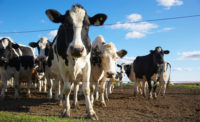Cultured meat can be produced from growing animal cells in-vitro rather than as part of a living animal. This technology has the potential to address several of the major ethical, environmental and public health concerns associated with conventional meat production. However, research highlights some consumer uncertainty regarding the concept. Although several studies have examined the media coverage of this new food technology, research linking different frames to differences in consumer attitudes is lacking.
That’s why the Department of Psychology, University of Bath, Bath, UK, and the University Studies, Portland State University, Portland, Ore., released a study that exposes U.S. adults to one of three different frames on cultured meat—“societal benefits,” “high tech” and “same meat.”
The study revealed that 64.6% of participants were probably or definitely willing to try cultured meat, and only 18.4% were probably or definitely not willing to try cultured meat, whilst 16.9% were unsure.
Similarly, optimistic rates were found with regards to participants' willingness to buy cultured meat regularly (49.1% were probably or definitely willing to do this; 24.5% were probably or definitely not willing to; 26.4% were undecided) and willingness to eat cultured meat as a replacement for conventional meat (48.5% were probably or definitely willing to do this; 26.6% were probably or definitely not willing to; 24.9% were undecided). Of the 243 participants who currently ate plant-based meat substitutes, 49.8% were somewhat or more likely to eat cultured meat; 25.5% were somewhat or less likely and 24.7% were undecided.
In terms of gender, men had more positive views of cultured meat than women, on average. These differences were significant with respect to attitude, perceived safety, perceived taste, perceived benefits for society, willingness to try, willingness to buy regularly, willingness to replace conventional meat and willingness to eat over plant-based alternatives. However, men were more concerned about the cost compared to women.
Age was also a factor, as younger people generally had more positive views than older people, with a steady decline in attitudes in older age groups. For instance, the 56-plus age group was an exception, as it tended to have more positive views than those in the 36-45 and 46-55 age groups.
Participants with different diets also had differing views on cultured meat. Vegetarians/vegans were significantly less willing to try cultured meat than meat/fish-eaters and significantly less willing to eat cultured meat compared to plant-based alternatives, but meat/fish-eaters had significantly higher concerns about the taste, naturalness and safety of the product.
Green framing
Framing effects in terms of products and product features has more recently become a rich line of investigation. Work has been done on the type of frame employed and its effects in terms of willingness to pay, product preferences and brand loyalty. For example, scholars suggest that positive frames are generally more effective than negative ones, allowing for the fact that there are occasions where a negative frame might be advantageous.
This study demonstrates that those who encounter cultured meat through the “high tech” frame have significantly more negative attitudes toward the concept, and are significantly less likely to consume it.
Research also focused on the effectiveness of marketing products in terms of social causes, particularly the environment. For example, the study revealed that while making green claims enhanced consumer favorability toward the brand, fewer claims rather than more were preferred. The study also revealed that green frames worked best when they highlighted the consumer's own environmental impact. And, a consumer's motivations impacted how favorably they responded to green framing techniques.
Of particular relevance here is the research on framing of genetically modified (GM) foods. Media coverage on GM foods has been shown to have a significant impact on public perceptions of, and behavior toward, the technology. Researchers identified coverage on GM foods to be primarily driven by specific events such as food scares and environmental events.
Coverage has been different in different countries, however. Whilst U.S. coverage of GM foods focused on the scientific-economic elements of the technology, German coverage was focused on the practical ethics and British coverage was focused on the public discourse. Coverage in the United States was generally more positive than in the UK, and in China, was universally positive or neutral. And, Hungarian coverage was particularly polarized.
Cultured meat
“Cultured meat” enable processors to sustainably produce meat, while reducing animal suffering on an enormous scale. However, research into public perceptions of cultured meat indicates that some consumers may have reservations around the concept.
Although many consumers recognize the potential ethical and environmental benefits of cultured meat, some have concerns about its alleged unnaturalness, which can lead to concerns about food safety. Recent studies have demonstrated how these perceptions can be invoked or avoided by different framings. Meanwhile, less technical descriptions of cultured meat lead to higher consumer acceptance compared to more technical descriptions.
These findings are relevant for the interpretation of much of the existing research on cultured meat. For instance, many consumers in their focus groups reacted with disgust to the concept, and perceived few personal benefits—yet, these responses were influenced by the video participants shown, which describes “synthetic meat” being grown in labs. Likewise, an analysis of online comments on news stories about cultured meat note “…the framing of the issue in each individual article may have influenced perceptions of [cultured meat].”
Therefore, the framing of cultured meat is likely to have a substantial impact on consumer perceptions. European and U.S. media coverage of cultured meat discusses its benefits, production process, timescale, history and skeptics, yet naturalness is a key focus in Australian print media. Indeed, stories about cultured meat frequently feature “science-themed” photos such as meat in a petri dish in a lab. Meanwhile, coverage in western media focuses on the reactions of vegetarians.
Methods
The survey tested the effect of different framings of cultured meat on consumer attitudes, beliefs and behavioral intentions.
Participants
Participants were U.S. adults recruited through Amazon MTurk, a microtasking platform used in social research. MTurk enables researchers to get high-quality data from a sample that is more representative than college samples.
Procedure
First, participants read information about the study, as well as identified gender, age group, region and which foods they eat. These foods were later used to determine diet.
Next, participants indicated whether they heard of cultured meat before. They then read the following description of cultured meat:
“Clean meat (also called cultured meat or in-vitro meat) is real meat [that] is grown from animal cells without the need to raise animals. It should not be confused with meat substitutes such as soy. Since it is real animal meat, it has the same taste, texture and the same or better nutritional content as conventionally-produced meat.”
Next, participants gave one word that described cultured meat. This was an open question, and was later used to identify illegitimate responses. Participants also indicated how familiar they were with cultured meat on a 5-point Likert scale (1 = Not at all familiar, 5 = very familiar).
Participants were then allocated to one of three experimental conditions. Next, participants were asked to rate their attitude toward cultured meat on a 5-point Likert scale (1 = Very favorable, 5 = Very unfavorable).
Participants were then asked to rate their agreement with five statements about cultured meat on 5-point Likert scales (1 = Strongly disagree, 5 = Strongly agree). The statements were about cultured meat's healthiness, safety, environmental friendliness, sensory quality and benefits for society. Next, participants rated four concerns about cultured meat using 5-point Likert scales (1 = Not at all concerned, 5 = Extremely concerned). The concerns were about cost, taste, naturalness and safety.
Finally, participants rated their willingness to eat cultured meat using 5-point Likert scales (1 = Definitely yes, 5 = Definitely No). Participants were asked about their willingness to try cultured meat, willingness to buy cultured meat regularly, willingness to eat cultured meat as a replacement for conventionally produced meat and willingness to eat cultured meat compared to plant-based meat substitutes.
Experimental design
The experimental design allows participants to see one of three framings before answering questions about cultured meat.
These three framings represent common discourses on cultured meat. Potential societal benefits, the technical scientific nature of the product and the sensory similarity to conventional meat are all themes that occur in media coverage.



